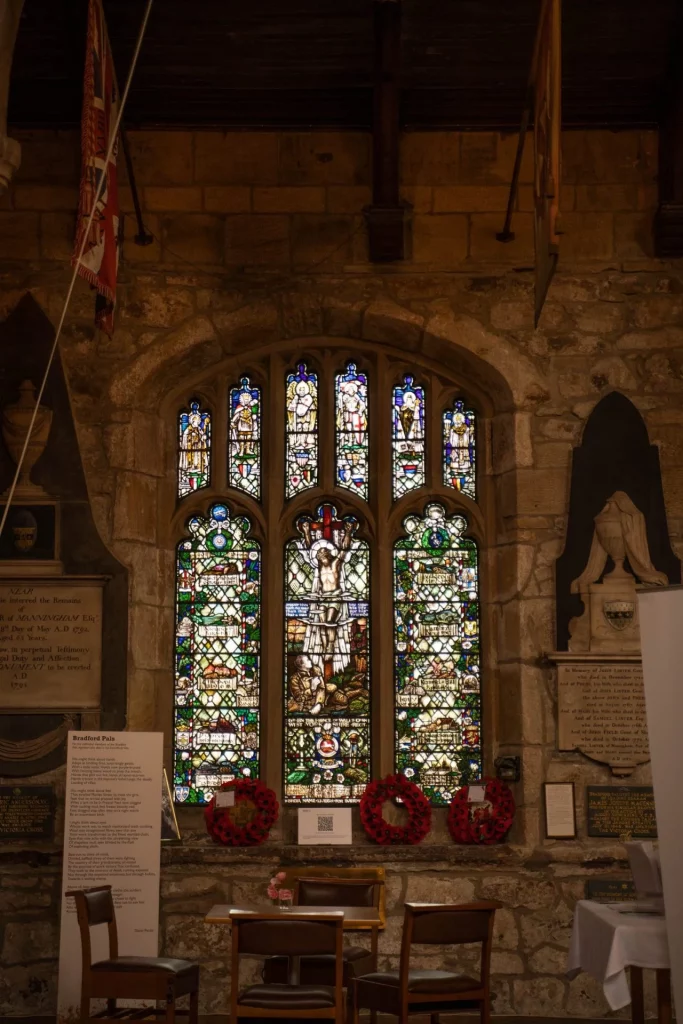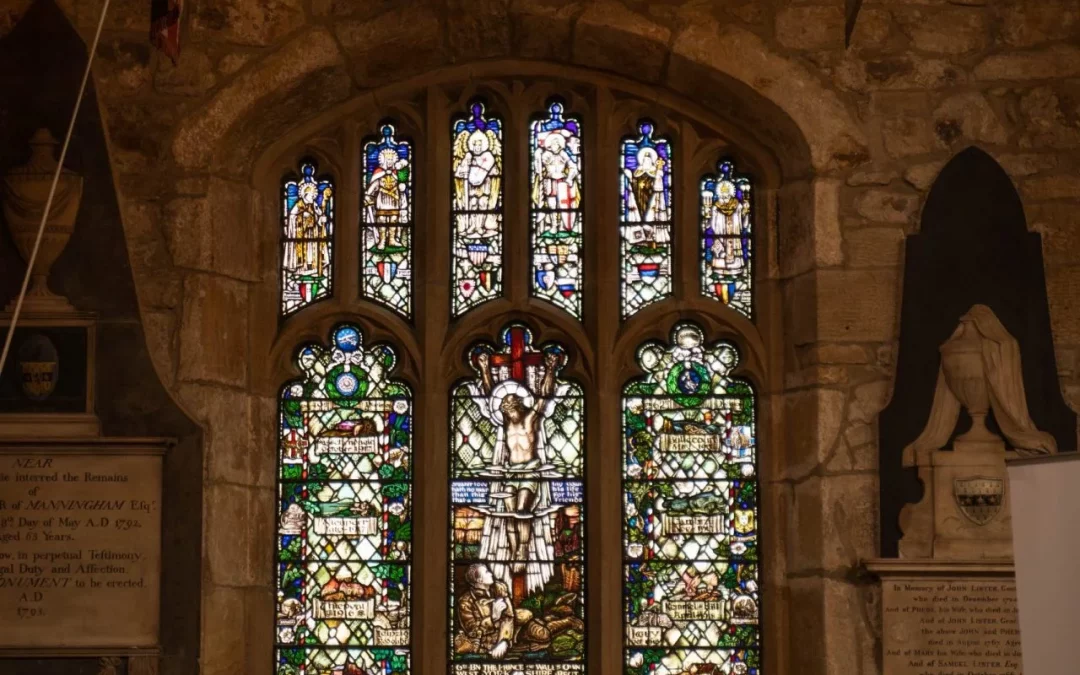War, peace and remembrance.
The story of the Cathedral’s World War I Memorial Window, begins with the events of the Great War. 1914 saw the start of a conflict in Europe that was to impact on people across the globe. Bradford, like all cities, towns and villages in Britain was touched by this conflict which people at the time believed was ‘the war to end all wars’. It was fought on a huge scale and involved approximately seventy million people in combat across Europe, the Mediterranean and the Middle East. The men enlisted in the British armed services, came from across the British Empire including from Australia, Canada, the Caribbean, India, Nepal, New Zealand and the Union of South Africa.
The biggest volunteer regiments were in the British Indian Army; one and a half million men from the countries now known as India, Pakistan and Bangladesh fought in the conflict. Many families resident in Bradford today, who have their heritage in these countries, had family members affected by or who fought in the First World War. Their families shared a similar experience to those living in Bradford.
Britain’s allies in the First World War were America, Japan and Russia (the Allies). The nations on the opposing side (the Central Powers), were Germany, Austro-Hungary and the Ottoman Empire.
The West Yorkshire Regiment
The British Army’s 14th regiment the ‘Prince of Wales’s Own’ became the 14th (Buckinghamshire – The Prince of Wales’s Own) Regiment of Foot, managed to avoid amalgamation with any other Regiment in 1881 when the British Army was restructured, but were re-titled “The Prince of Wales’s Own” (West Yorkshire Regiment). They onto serve in the Gold Coast of Africa in 1895, the Boer War (1899-1902) World War I (1914 – 1918) and World War II (1939 – 1945).
Bradford’s Men and Boys
In Bradford many young men and boys rushed to join the armed forces in the early months of the War. As elsewhere in the country they often joined the army with friends; they had things in common, such as a shared place of work, a shared church, or a shared hobby. By the 26th September 1914 a full battalion of one thousand and sixty nine men had been created, the 16th Battalion West Yorkshire Regiment (1st Bradford). As the War progressed a second Bradford battalion was formed. The 18th Battalion West Yorkshire Regiment (2nd Bradford) commenced enlistment on February 8th 1915. These battalions are often collectively referred to as the ‘Bradford Pals’. Many men from the Cathedral community joined the army as volunteers, or because by law they had to do so; it became a requirement in 1916 for all able bodied men aged between 18 and 40 years to enlist for military service, unless they were widowed with children, in a reserved occupation, or ministers of a religion. This was known as conscription.
Many Bradford men and boys lost their lives in the First World War. For example the 1st and 2nd
Bradford Pals, suffered a huge number of casualties, as they attacked the heavily fortified village of Serre on the Somme, in France, on the 1st July 1916. Many of the men and boys who lived, worked, socialised and joined the army together, also died together. Their loss had a huge impact on the City and the people they left behind. The sacrifice, the freedom and the peace hard won by those who fought and died, is commemorated in memorials around the Cathedral, and in particular by the World War I Window and the Cathedral’s 10 Memorial Bells. The inscriptions on the Memorial Window and on one of the Bells, record the people of Bradford’s acknowledgement of this sacrifice and their gratitude for the blessings of victory, peace and freedom, affirming:
“Greater love hath no man than this that a man lay down his life for his friends.”
John 15:13

A quick guide to the images on the window.
Top Lights
The upper part of the window shows the nations who fought with Britain in World War I, who were not part of the British Empire. From left to right Saint Ambrose of Italy, Saint Louis the Soldier Saint and King of France, St Michael of Belgium (with shields showing Japan and USA too), St George of England (with shields showing Britain, Portugal and Russia too), St Sava of Serbia, St Methodius of Romania. The largest number of volunteers in the British army came from India, then a British colony; others who fought in the British forces came from Canada, Australia and the Caribbean.
Left Hand Panel
From the top:
- Aeroplanes, Tudor rose within laurel wreath of the 49th Division
- Stretcher bearers in front of red cross on white field
- Centre scene on battlefield of ‘Passchendaele’ October 1917
- Right border: spade in trench
- Left. border: ship riding waves ‘left flank’
- Centre – two machine gunners at Lake Nieuport, July 1917
- Right border – German grenade
- Left border – soldier throwing grenade ‘bombers’
- Centre scene of town on fire – Thiepval 1916
- Right border – scene of trenches ‘Leipzig redoubt’
- Left.border- Shield of arms of Ypres
- Centre Town on fire, being bombed.Cathedral on right. Ypres. 1915,16,17.
- Right.border Infantryman holding white flag
- Left border Shield
- Centre Blue sky with stars – on left a troopship; on right 5 soldiers landing at night. ‘Landed in France 15 April 1915
- Right border City of Bradford arms. Borders-scenes alternate with sprays of the white rose of York.
Centre Panel Jesus on Cross – ‘Greater love hath no man that this, that a man lay down his life for his friends.’ (John 15:13)
From the top:
- Soldier in the khaki uniform of West Yorkshire Regiment
- Identity disc, rifle, canvas bag
- Tree, support ropes, church, grave with headstone cross and laurel wreath/poppies
- Battlefield, grave with upright rifle and helmet
- Regimental badge of Prince of Wales Own West Yorkshire Regiment.
Right Hand Panel
From the top:
- Top – shellburst, balloon, pelican in wreath (there are other tiny pelicans in these windows – a Christian symbol of self-sacrifice. Around the Cathedral are other pelicans – on the Bishop’s Throne, the Dean’s Stall, in the Holy Spirit Chapel, and on the Font).
- Left border – sprays of the white rose of York
- Centre – Battlefield Belle Court May 1917
- Right border – flag, pack mule. ‘Transport’
- Left border – Yorkshire roses
- Centre Tanks – Cambrai November 1917 (the first major tank battle in history).
- Right border – Arms of Cambrai
- Left border – Fieldgun Iway. October 1918
- Centre – windmills on fire, Kemmel Hill April 1918.
- Right border – two soldiers with wireless. ‘Signallers’
- Left border – trumpets and drums above a white horse; ‘Famars’
- Centre – town on fire, shells bursting. ‘Valenciennes Nov.1918’
- Right border – Arms of Valenciennes
- Left border – Arms of Diocese of Bradford (formed 1919)
- Centre – town on the Rhine with Cathedral – Cologne
- ‘Reached the Rhine February 1919’
- Right border Yorkshire roses.
Women, at War and Peace
Women played an enormous part in the First World War. In Bradford they became nurses, tram drivers and post women; they worked in factories and on the land. For some women, working was doing their bit to help the War effort, or it was a matter of necessity as it always had been, they needed the money to survive. For others it was a chance to seize new opportunities and experiences. Many of these women were the mothers of those fighting, others of course were sisters, wives and girlfriends. The majority of women were touched in some way by the War.
Female opinions on the War varied greatly, even the Suffragette movement was divided between those who saw the War as being a patriotic struggle and justifiable and those who campaigned for peace and thought the suffering and loss of life were unacceptable. Both points of view were represented among Bradford’s female population. In Bradford the voices of women and men campaigning for peace could be heard before, during and after the War. Some members of the Independent Labour Party, the Trades Council, Quakers and some Christians, spoke out for peace. When conscription was introduced in 1916, conscientious objectors, who were against the War for political or religious reasons refused to enlist and fight. Some COs were willing to take on none combatant roles such as that of an ambulance driver, others refused to wear a uniform or do anything that would support the War in any way. They were sent to prison for refusing to fight. COs were in a minority and were not popular.
The Women’s International League for Peace and Freedom was established in 1915 and met initially in The Hague. Their desire for peace did not meet with universal approval. The Bradford Women’s Humanity League evolved from this movement. It was formed ten days after conscription was introduced in 1916 and held many anti-war meetings. In September 1917 3,000 women took part in an anti-war demonstration, marching across the City from the Textile Hall on Westgate and ending near Bradford College. They were accompanied by a band and carried banners bearing slogans such as:
“The Boys in the Trenches want Peace” and “I want my Daddy” [1]
Women and Remembrance
Women were at the forefront of attempts to make sure that those who died in the First World War were not forgotten. An international symbol, the red Remembrance Poppy was the result of the American Moina Mitchell’s efforts to raise money for veterans.
The idea was developed by Anna Guirin in France and eventually adopted by General Haig, to raise money for British veterans of the First World War and their families. In the centre of the red Remembrance Poppy was the slogan ‘The Haig Appeal’. The Women’s Co-Operative Guild campaigned for this to be replaced with the word ‘Peace’. They were unsuccessful and so introduced their own white Peace Poppy in 1926. Red Remembrance Poppies were made and sold in Britain for the first time in 1921, the year in which the Memorial WWI Window and Memorial Bells were placed in the Cathedral.
In 1994 the decision was made to replace the words the ‘Haig Fund’ in the centre of the re poppy with the words ‘Poppy Appeal’. White poppies still display the word ‘peace’.

